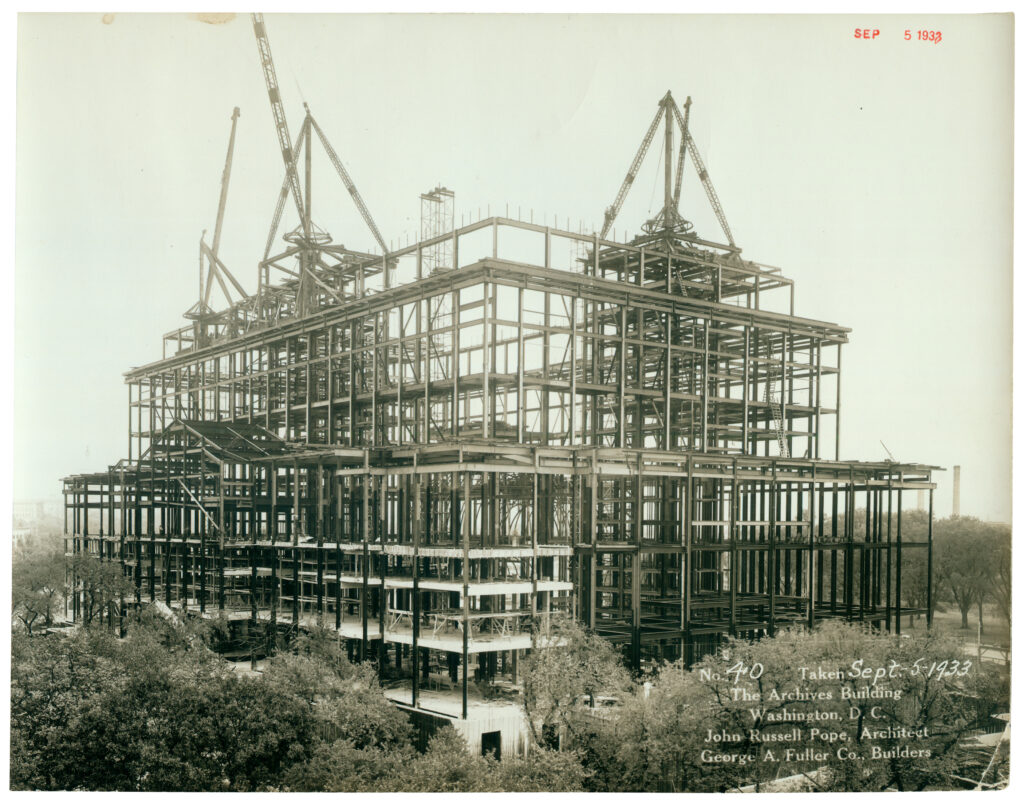2. BUILDING CONSTRUCTION

Considerations and Rationale:
After selecting a building site, the next step is to begin construction of the Archival facility. The facility should be constructed and designed in a way that will provide a safety net for the records that will be stored in the facility. The SAA, therefore, reasoned that building construction would be critical in the preservation of an archive records.
GUIDELINES
When constructing an archival facility, the SAA provides the following guidelines:
- Archive facilities must be constructed with noncombustible materials and incorporate fire protection systems and structural systems that avoid catastrophic failure due to an uncontrolled fire, natural disaster, or industrial disaster (SAA, 2009, p.19).
- Building construction must implement as many methods as possible to guard against water intrusions (SAA, 2009,p.19).
- Archival facilities must be fully accessible and comply with the Americans with Disabilities Act (ADA) and other laws that apply to accessibility (SAA, 2009, p.19).
- Construction that is conducted below ground should consist of measures to prevent water intrusion and moisture infiltration through the foundation. Simultaneously, the builder should avoid constructing a facility that would require pumps to prevent groundwater from rising into the structure (SAA, 2009, p.20).
- Building framing materials should be made of steel masonry, or concrete (SAA, 2009, p.23).
- Exterior walls must be of fire resistant durable products (such as masonry) (SAA, 2009, p.23).
- Interior systems should be easy to maintain and constructed of durable fire resistant products (SAA, 2009, p. 23).
- Building envelope should be designed and constructed to minimize or eliminate air infiltration through the walls, windows, doors, and roof to avoid condensation that leads to mold an other environmental problems(SAA, 2009, pp.23-24).
- Floors should be constructed of steel reinforced concrete, and sized to withstand the heavy loads placed upon them by the archival material and its shelving(SAA, 2009, p.24).
- Seismic code compliant (SAA, 2009, p.24)
- Builders should not construct pools or fountains within an archive facility (SAA, 2009, p.25).
- Builders should ensure that all exterior openings into the building are constructed in such a way as to prevent animals such as birds, bats, vermin and insects from entering the building(SAA, 2009, p.25). Particularly in exterior foundation gaps, exterior roll doors, loading dock areas, attic windows aerators, and floor drains (SAA, 2009, p.25).
- Roofs should be constructed with durable, long lasting and noncombustible materials and should be designed to be easily accessible for replacement during the life of the building (SAA, 2009, p.25). The roof should also be designed to prevent water leaks on the material. Installing water sensors in the archival stacks to detect leaks in the roof and sprinkler systems is advised(SAA, 2009, p.26).
- Skylights and sloped windows should not be located over archival stacks, exhibit or laboratory areas (SAA, 2009, p.26).
- Archive facilities should be designed in such a way as to allow proper building maintenance. The facilities should allow access for service and replacement for all the buildings systems including mechanical, plumbing, electrical, fire protection, and security(SAA, 2009, p.27). Mechanical facilities should be constructed in such a way that it does not permit entrance into the archival storage spaces (except for those that are specifically located in archive storage spaces, such as lights and light fixtures)(SAA, 2009, p.27).
- Archive stacks should be placed separate from areas dedicated to Heating, Ventilation and Air-Conditioning (HVAC) systems(SAA, 2009, p.27).
- Archive Stacks should be separated from pollutants, such as the loading dock, machine rooms, or spaces where cooking, painting, exhibit production, and other such activities take place(SAA, 2009, p.27).
- Loading docks, food preparation areas and exhibit production areas shoudl be kept under negative pressure in relation to adjacent spaces. Negative air pressure is especially useful in loading docks, due to the fact that trucks and vehicle engines in particular, which are prone to producing of airborne pollutants and combustion gases (SAA, 2009, p.27).
- Screening should be added to all floor drains to prevent insects and vermin from entering the building(SAA, 2009, p.29).
- When constructing electrical systems into an archival facility, builders should consider the overall energy consumption of the building–including spare conduits, breaks, and power distribution capacity in all systems (SAA, 2009, p.29).
- A standby emergency power generator should be supplied for archival facilities–particularly egress and exit lighting, fire alarm system, smoke control system, and fire pump (SAA, 2009, p.29).
- Building commissioning should be considered (SAA, 2009, p.30)


